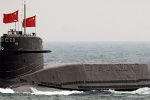Multiplying Hotbeds of Tension
Over the past decade the South China Sea has once more transformed into a hotbed of tension. China’s unprecedented island-building campaign, military build-up and uncompromising sovereignty claims have plunged the region into ebullition and anxiety. Disqualifying most of China’s claims and actions in the region, the recent ruling of the Arbitral Tribunal, far from appeasing the situation, has added fuel to the fire. In a latest twist, the Philippines, the most reliable long-term ally of the United States in the region, has, under the mercurial leadership of President Duterte, heightened the confusion by engaging into a sudden rapprochement with China.
The South China Sea has been of strategic importance and prone to foreign intervention since ancient times. Home to one of the world’s most vital sea lanes with over 74,000 vessels plying its route annually, the South China Sea constitutes the backbone of the world’s trading system. It harbours extensive fish stocks and untapped hydrocarbon resources, attracting the covetousness of coastal states and foreign investors alike.
On the global level, the South China Sea – not unlike its northern neighbour, the East China Sea – is a compelling showcase of the world’s changing security architecture and shifting balance of power. China’s seemingly irresistible economic and military rise is challenging the status quo and the United States’ proclaimed role as guarantor of stability in the region. In a possible clash of titans, the two superpowers are confronting each other, vying for no less than global leadership.
Chinese leadership is ogling with an alternative world order that would restore the nation’s ancient glory and overcome the scar left by the 100 years of humiliation initiated by the Opium Wars. Since Deng Xiaoping’s paradigmatic shift to trade and economic openness, Chinese rulers have come to conceive maritime security as tantamount to China’s national interest and the South China Sea as a key strategic zone.
Putting their rhetoric of peaceful development to the litmus test, China’s decision-makers aim at the role of benevolent hegemon in the region, in a way reminiscent of the Middle Kingdom’s former tributary system. Insisting that disputes in the South China Sea are a local issue, China strives to keep the United States at bay by concluding bilateral settlements with members of the Association of Southeast Asian Nations (ASEAN).
Considering the South China Sea as a bellwether to decrypt China’s agenda on the world stage, the United States has decided to confront China’s assertiveness by rebalancing its global priorities. Since 2010 the Obama administration has gradually redeployed naval and air assets from Europe and the Middle East to the Asia-Pacific through its pivot policy of re-engagement.
Concomitantly, the United States has aimed to constrain China through collective action in the multilateral framework of ASEAN. The latter, however, has thus far proven unable to enforce a shared regional security agenda and saw most of its initiatives thwarted. Trump’s recent election and fierce rhetoric about China have added to the uncertainty of the situation.
The states bordering the South China Sea – China, Vietnam, the Philippines, Indonesia, Malaysia, Brunei and Taiwan – hold rivalling sovereignty claims over disputed reefs, rocks and islands such as the Spratlys or the Paracels. Adding further tension, many regional powers have recently witnessed a concomitant surge in nationalist rhetoric and marked increase in military spending.
Recent skirmishes such as the USNS Impeccable incident (2009) between US and Chinese vessels or the standoffs between Chinese and Philippine forces at Reed Bank (2011), Scarborough Shoal (2012) and Second Thomas Shoal (2013–16) pose a serious risk to regional and global security in the absence of functioning conflict prevention or dispute settlement mechanisms. Similar flashpoint incidents are likely to occur in the near future, which indubitably raises the spectre of a serious war in the South China Sea.
To launch the first issue of Global Challenges, six researchers and professors therefore propose contributions probing whether the South China Sea is indeed breeding the potential for military conflict.
-
1
 Antagonisms in the South China Sea: The Regional Perspective
Antagonisms in the South China Sea: The Regional PerspectiveDr Christian Wirth reviews how regional powers compete over resources and sovereignty in the South China Sea. He exposes the limits of the law of the sea (UNCLOS) as well as of ASEAN, under the impression of growing nationalist sentiments, to provide means for the relaxation of the stiffening geopolitical context.
-
2
 A Sea at the Heart of Chinese National Interest
A Sea at the Heart of Chinese National InterestChinese territorial and maritime claims over large swaths of the South China Sea are based not only on economic and security considerations, but also on national identity making and the renewal of China’s past grandeur. For Vis. Prof. Nicola Casarini, this issue is considered by Chinese leaders and the public opinion alike as “domestic” and not something over which other claimant states – and even less so the international community – should have a say.
-
3
 The US Pivot Strategy: A Change of Paradigm in the South China Sea?
The US Pivot Strategy: A Change of Paradigm in the South China Sea?Exploring the consequences of the US strategic redeployment towards the Asia Pacific, Prof. David Sylvan considers whether the pivot may lead to a new cold war in the region. Arguing that the pivot only marginally alters prior policies and military capability of the United States in the South China Sea, Prof. Sylvan concludes that US-China relations are likely to continue on a peaceful basis given the two powers’ ongoing cooperation on a series of global issues such as climate change and anti-terror policies.
-
4
 China and the United States: The Evolution of a Relationship
China and the United States: The Evolution of a RelationshipAdopting the perspective of the longue durée, Prof. Jussi Hanhimäki explores the history of US-China relations in the region. Arguing that the solid cooperation and common base of interests established since the historic visit of Nixon (1972) should suffice to prevent a major conflict in the South China Sea, Prof. Hanhimaki still sees two potential risks that could lead to conflict escalation: the rather unlikely hypothesis that the United States will be drawn into conflict by one of its local allies and the more serious threat posed by a change of domestic politics that could drag China or the United States into isolationism.
-
5
 Legal Victory for the Philippines against China: A Case Study
Legal Victory for the Philippines against China: A Case StudyChristine Pichel Medina, PhD graduate, explores the consequences of the recent ruling of the Arbitral Tribunal. Even though China refuses to recognise the ruling which is largely in its disfavour, some of its findings may prove seminal for the future: (a) any pre-existing historical rights as formulated by China in its nine-dash line are invalid as superseded by the regime established by UNCLOS; (b) China may not, through any activity, enhance the status of a feature in the South China Sea, e.g. from rock to island.
-
6
 Arms Race in the South China Sea: What Threshold?
Arms Race in the South China Sea: What Threshold?Umut Yüksel, PhD candidate, investigates whether the current arms race in the region risks escalating into a full-fledged war or whether, on the contrary, the region is witnessing a more ordinary phenomenon of military modernisation by fast-growing countries. In particular, Yüksel gives a closer look at the Chinese build-up of military bases on land reclaimed from coral reefs and recent acquisition of a nuclear submarine fleet. He concludes that it is the US military engagement to the region and ongoing commitment to its regional allies that will ultimately prove determinant for the sequel of the military build-up in the South China Sea.
-
O
 Uncertainty in the South China Sea in the Wake of Trump’s Inauguration: The Risk of Escalating Rhetoric
Uncertainty in the South China Sea in the Wake of Trump’s Inauguration: The Risk of Escalating RhetoricGoing back to the initial question of whether war is on the horizon in the South China Sea, Dr Dominic Eggel argues in this outlook that much will depend on the attitudes and strategies adopted by the new US administration. As tensions and scuffles in the region are bound to continue, functioning communication (back-)channels, conflict management measures, and a sufficient degree of mutual understanding between the United States and China are more important than ever to prevent conflicts from escalating.
The objective of Global Challenges is to untangle complex pressing international issues by offering fresh interdisciplinary perspectives from faculty and students of the Graduate Institute as well as external experts. These research dossiers ambition to be pedagogically accessible for all and come in an innovative format using boxes, charts, diagrams, maps, interviews, videos and infographics. We hope you will enjoy reading this first issue.
Editors' note:
This research dossier was written until January 2017 and therefore does not take into account recent developments regarding the South China Sea.
South China Sea: Elementary Data
East Asia
3.5 million km²
Brunei, China, Indonesia, Malaysia, the Philippines, Taiwan, Vietnam.
Petroleum, natural gas and fisheries products.
Each year, USD 5.3 trillion of trade passes through the South China Sea; US trade accounts for USD 1.2 trillion of this total.
The South China Sea contains over 250 small islands, atolls, cays, shoals, reefs and sandbars, most of which have no indigenous people, many of which are naturally under water at high tide, and some of which are permanently submerged.
Source: by Galvin and whybe.ch.
The Disputed Islands
The Spratly Islands are a disputed group of 14 islands, islets and cays and more than 100 reefs, sometimes grouped in submerged old atolls. The archipelago lies off the coasts of the Philippines, Malaysia and southern Vietnam. The islands have no indigenous inhabitants, but offer rich fishing grounds and may contain significant oil and natural gas reserves. Some of the islands have civilian settlements, but of the approximately 45 islands, cays, reefs and shoals that are occupied, all contain structures that are occupied by military forces from Malaysia, Taiwan, China, the Philippines and Vietnam. Additionally, Brunei has claimed an exclusive economic zone (EEZ).
The Paracel Islands are a group of islands, reefs, banks and other maritime features. They are controlled (and occupied) by China, and also claimed by Taiwan and Vietnam. The archipelago is surrounded by productive fishing grounds and a seabed with potential, but as yet unexplored, oil and gas reserves.
Scarborough Shoal is a disputed territory claimed by China, Taiwan and the Philippines. Since the 2012 Scarborough Shoal standoff, access to the shoal has been restricted by China. Scarborough Shoal forms a triangle-shaped chain of reefs and rocks with a perimeter of 46 km. It covers an area, including an inner lagoon, of 150 km2. The shoal’s highest point, South Rock, measures 1.8 m above water during high tide.
The Pratas Islands are an atoll in the north of the South China Sea consisting of three islets about 340 km southeast of Hong Kong. Excluding their associated EEZ and territorial waters, the islets comprise about 240 ha, including 64 ha of lagoon area. China claims the islands, but Taiwan controls them and has declared them a national park. The main island of the group, Pratas Island, is the largest of the South China Sea islands.
Macclesfield Bank is an elongated sunken atoll of underwater reefs and shoals. It lies east of the Paracel Islands, southwest of the Pratas Islands and north of the Spratly Islands. Its length exceeds 130 km southwest-northeast, with a maximal width of more than 70 km. With an ocean area of 6,448 km2 within the outer rim of the reef, although completely submerged without any emergent cays or islets, it is one of the largest atolls of the world. Macclesfield Bank is claimed, in whole or in part, by China and Taiwan.

